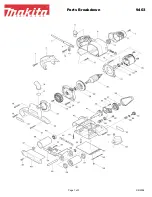
24 | GB
c) Keep children and bystanders away while op-
erating a power tool.
Distractions can cause you
to lose control.
2) Electrical safety
a) Power tool plugs must match the outlet. Nev-
er modify the plug in any way. Do not use any
adapter plugs with earthed (grounded) power
tools.
Unmodified plugs and matching outlets will
reduce risk of electric shock.
b) Avoid body contact with earthed or grounded
surfaces, such as pipes, radiators, ranges and
refrigerators.
There is an increased risk of elec-
tric shock if your body is earthed or grounded.
c) Do not expose power tools to rain or wet con-
ditions.
Water entering a power tool will increase
the risk of electric shock.
d) Do not abuse the cord. Never use the cord for
carrying, pulling or unplugging the power tool.
Keep cord away from heat, oil, sharp edges or
moving parts.
Damaged or entangled cords in-
crease the risk of electric shock.
e) When operating a power tool outdoors, use
an extension cord suitable for outdoor use.
Use of a cord suitable for outdoor use reduces the
risk of electric shock.
f) If operating a power tool in a damp location
is unavoidable, use a residual current device
(RCD) protected supply.
Use of an RCD reduces
the risk of electric shock.
3) Personal safety
a) Stay alert, watch what you are doing and use
common sense when operating a power tool.
Do not use a power tool while you are tired or
under the influence of drugs, alcohol or med
-
ication.
A moment of inattention while operating
power tools may result in serious personal injury.
b) Use personal protective equipment. Always
wear eye protection.
Protective equipment such
as a dust mask, non-skid safety shoes, hard hat or
hearing protection used for appropriate conditions
will reduce personal injuries.
c) Prevent unintentional starting. Ensure the
switch is in the off-position before connecting
to power source and/or battery pack, picking
up or carrying the tool.
Carrying power tools with
your finger on the switch or energising power tools
that have the switch on invites accidents.
4. lntended use
The intended use of this power tool is the sanding of
large areas of drywalls as a preparation before paint-
ing or wallpapering using suitable abrasive sheets.
This power tool is neither suited for the preparation
of small areas, corners and edges, nor for the remov-
al of wallpaper and the grinding of ceilings and wet
grinding.
Do not use the power tool for cutting or roughing or
polishing. Do not use it together with wire brushes.
Do not treat asbestos containing materials with this
power tool.
This power tool is solely intended for private use. Do
not use the power tool for any other purpose than for
the intended one. Any other use beyond the intended
use is improper.
For any resulting damage or injury, the user/Operator
is held liable, not the manufacturer.
WARNING!
Neither power tools nor packaging materials are
toys! Children must not play with plastic bags,
foils and small parts! Danger of swallowing and
suffocation!
5. General safety notes for power tools
m
WARNING: Read all safety warnings, instruc-
tions, illustrations and specifications provided
with this power tool.
Failure to follow all instructions
listed below may result in electric shock, fire and/or se
-
rious injury.
Save all warnings and instructions for future ref-
erence.
The term “power tool” in the warnings refers to your
mains-operated (corded) power tool or battery-operat-
ed (cordless) power tool.
1) Work area safety
a) Keep work area clean and well lit.
Cluttered or
dark areas invite accidents.
b) Do not operate power tools in explosive at-
mospheres, such as in the presence of flam
-
mable liquids, gases or dust.
Power tools create
sparks which may ignite the dust or fumes.
Summary of Contents for 935-33
Page 2: ...2...
Page 3: ...3 1 5 2 13 10 1 2 3 4 6 9 3 4 8 11 7 12 11 12 16 15 14 17 19 18 3...
Page 4: ...4 5 15 10 14 8 9 13 6 5 1 7 16 6 15 10 14...
Page 5: ...5 10 11 20 4 19...
Page 33: ...33...













































